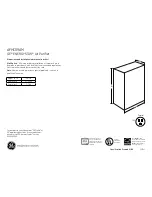
8
Features and Benefits
3-Speed Indoor Fan Motor
for selectable HIGH and LOW speeds
Since the ZVAC discharge air may be routed through duct
work for air distribution into the room and into other rooms,
the units are equipped with a 3-speed fan to provide greater
air movement, to compensate for the additional duct length.
GE recommends an HVAC engineer be consulted to determine
the best fan speed for the application.
A switch on the unit (dip switch #5-duct) adjusts the two-speed
fan system to different settings. With the switch in the UP
position, the system will operate using high and medium fan
speeds. With the switch in the DOWN position, the system will
operate using the medium and low fan speeds.
For example, on the 9,000 BTUH unit, the three fan speeds at
0.2" ESP provide 220 CFM on the lowest fan speed, 370 CFM on
the medium fan speed, and 480 CFM on the highest fan speed.
With the switch down, the unit would provide 220 CFM on
LOW speed and 370 CFM on HIGH speed. With the switch up,
the unit would provide 370 CFM on LOW speed and 480 CFM
on HIGH speed.
Higher CFMs tend to increase the operating sound level, both
from fan noise and from the air noise in the duct. Higher CFMs
also reduce the dehumidification rate of the unit, while lower
CFMs provide quieter operation and better dehumidification.
However, if the CFMs are not high enough to adequately move
the air through the duct system, the unit will not be able to
provide a comfortable room.
Corrosion Protection Treatment (Standard)
All ZVAC units are protected
against damage from seacoast
area corrosion. Components
that are in contact with the
salt air have special coatings
or are made of non-corroding
materials to help withstand
the corrosive effects of the
environment. This protection
includes the use of totally
enclosed fan motors with
painted casings, a special
coating on the outdoor coil, use of stainless steel screws and
brackets, and additional paint on components like the base pan.
Slinger Ring Condensate Removal
Condensate water removed from the indoor air is dispersed
into the air stream by the outdoor fan slinger ring and
deposited on the hot outdoor coil. The water helps cool the
refrigerant in the outdoor coil and increases the efficiency of
the air conditioner.
Indoor Coil Frost Control
Under certain operating conditions, frost can form on the indoor
coil of an air conditioner, reducing air flow, and causing a lack
of cooling complaint. In order to prevent frost from forming, the
ZVAC has an automatic frost control on the indoor coil. When
frost begins to form on the coil, the compressor stops until the
coil temperature increases and the frost dissipates.
At this time, the compressor resumes operation and cooling
continues. The indoor fan remains running during the time
the compressor is off to help warm the coil with room
temperature air.
Automatic Compressor Random Restart
In the event of a power interruption, all compressors
attempting to restart immediately when power is restored
can result in a power surge that can cause another power
failure. The microprocessor in the ZVAC unit has a random
restart logic system that prevents all compressors from
restarting at the same instant.
Compressor Restart Delay
ZVAC units are designed to provide a minimum of three
minutes of compressor off time to allow refrigerant pressures
to equalize before attempting to restart. Attempting to restart
against a high head pressure shortens compressor and
overload protector life.
The units are also designed to provide a minimum of three
minutes of compressor run time to prevent short cycling from
disturbing the room occupant.
Quick Heat Recovery (On Heat Pump Units)
Heat pumps save money compared to electric resistance
heat, but if the unit cannot provide room occupant comfort,
the savings may be of questionable benefit. GE has years of
experience with designing Zoneline heat pumps to solve the
problem of guest complaints.
The heat pump unit incorporates a two-stage heat/one-stage
cooling thermostat that utilizes the resistance heat to bring the
room temperature to within 2°F. of the thermostat set point
before initiating heat pump operation. This method addresses
the two major complaints about heat pump operation: taking
too long to warm the room and low discharge air temperature.
Full electric resistance heat is utilized when the unit is first
turned on or when the unit is operating in heat pump mode
and the temperature in the room falls more than 2
°
F. below
the thermostat set point.
Extended Heat Pump
Operation/Reverse Cycle Defrost
Heat exists in the outdoor air at temperatures even below 0°F.
Many central systems, with larger outdoor coils, operate in the
heat pump mode down to temperatures in the mid-teens or
even to single-digit temperatures. Central systems are able






































